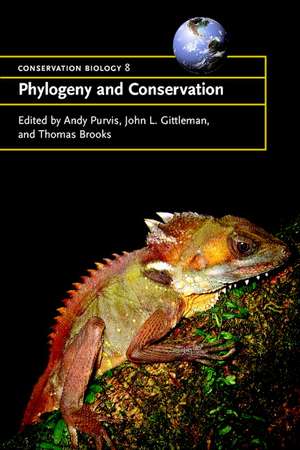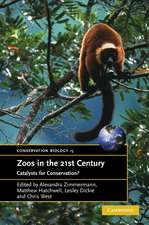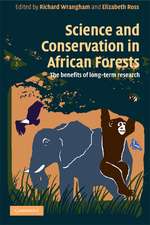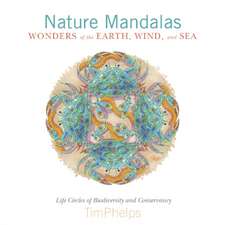Phylogeny and Conservation: Conservation Biology, cartea 10
Editat de Andrew Purvis, John L. Gittleman, Thomas Brooksen Limba Engleză Paperback – 21 sep 2005
Din seria Conservation Biology
- 11%
 Preț: 510.79 lei
Preț: 510.79 lei -
 Preț: 396.12 lei
Preț: 396.12 lei - 11%
 Preț: 474.83 lei
Preț: 474.83 lei - 18%
 Preț: 997.88 lei
Preț: 997.88 lei -
 Preț: 428.90 lei
Preț: 428.90 lei - 18%
 Preț: 957.44 lei
Preț: 957.44 lei - 11%
 Preț: 521.80 lei
Preț: 521.80 lei - 15%
 Preț: 532.38 lei
Preț: 532.38 lei - 18%
 Preț: 1233.37 lei
Preț: 1233.37 lei - 11%
 Preț: 519.62 lei
Preț: 519.62 lei - 11%
 Preț: 482.28 lei
Preț: 482.28 lei - 18%
 Preț: 948.92 lei
Preț: 948.92 lei - 11%
 Preț: 599.15 lei
Preț: 599.15 lei - 14%
 Preț: 772.46 lei
Preț: 772.46 lei - 11%
 Preț: 425.79 lei
Preț: 425.79 lei - 15%
 Preț: 644.49 lei
Preț: 644.49 lei - 11%
 Preț: 526.94 lei
Preț: 526.94 lei - 11%
 Preț: 597.21 lei
Preț: 597.21 lei -
 Preț: 383.33 lei
Preț: 383.33 lei -
 Preț: 364.04 lei
Preț: 364.04 lei - 11%
 Preț: 475.17 lei
Preț: 475.17 lei - 15%
 Preț: 646.62 lei
Preț: 646.62 lei - 11%
 Preț: 505.11 lei
Preț: 505.11 lei - 18%
 Preț: 942.94 lei
Preț: 942.94 lei - 11%
 Preț: 600.56 lei
Preț: 600.56 lei - 24%
 Preț: 1058.94 lei
Preț: 1058.94 lei - 18%
 Preț: 1240.62 lei
Preț: 1240.62 lei - 11%
 Preț: 513.79 lei
Preț: 513.79 lei -
 Preț: 459.88 lei
Preț: 459.88 lei - 18%
 Preț: 944.36 lei
Preț: 944.36 lei - 24%
 Preț: 790.97 lei
Preț: 790.97 lei - 11%
 Preț: 567.97 lei
Preț: 567.97 lei
Preț: 511.40 lei
Preț vechi: 574.61 lei
-11% Nou
Puncte Express: 767
Preț estimativ în valută:
97.85€ • 102.54$ • 80.90£
97.85€ • 102.54$ • 80.90£
Carte tipărită la comandă
Livrare economică 11-25 aprilie
Preluare comenzi: 021 569.72.76
Specificații
ISBN-13: 9780521532006
ISBN-10: 0521532000
Pagini: 448
Ilustrații: 33 b/w illus. 2 colour illus. 30 tables
Dimensiuni: 152 x 230 x 30 mm
Greutate: 0.71 kg
Editura: Cambridge University Press
Colecția Cambridge University Press
Seria Conservation Biology
Locul publicării:Cambridge, United Kingdom
ISBN-10: 0521532000
Pagini: 448
Ilustrații: 33 b/w illus. 2 colour illus. 30 tables
Dimensiuni: 152 x 230 x 30 mm
Greutate: 0.71 kg
Editura: Cambridge University Press
Colecția Cambridge University Press
Seria Conservation Biology
Locul publicării:Cambridge, United Kingdom
Cuprins
1. Phylogeny and conservation Andy Purvis, John L. Gittleman and Thomas M. Brooks; Part I. Units and Currencies: 2. Molecular phylogenetics for conservation biology Elizabeth A. Sinclair, Marcos Pérez-Losada and Keith A. Crandall; 3. Species: demarcation and diversity Paul-Michael Agapow, 4. Phylogenetic units and currencies above and below the species level John C. Avise; 5. Integrating phylogenetic diversity in the selection of priority areas for conservation: does it make a difference? Ana S. L. Rodrigues, Thomas M. Brooks and Kevin J. Gaston; 6. Evolutionary heritage as a metric for conservation Arne Ø. Mooers, Stephen B. Heard and E. Chrostowski; Part II. Inferring Evolutionary Processes: 7. Age and area revisited: identifying global patterns and implications for conservation Kate E. Jones, Wes Sechrest and John L. Gittleman; 8. Putting process on the map: why ecotones are important for preserving biodiversity Thomas B. Smith, Sassan Saatchi, Catherine Graham, Hans Slabbekoorn and Greg Spicer; 9. The oldest rainforests in Africa: stability or resilience for survival and diversity? Jon C. Lovett, Rob Marchant, James Taplin and Wolfgang Küper; 10. Late Tertiary and Quaternary climate change and centres of endemism in the southern African flora Guy F. Midgley, Gail Reeves and C. Klak; 11. Historical biogeography, diversity and conservation of Australia's tropical rainforest herpetofauna Craig Moritz, Conrad Hoskin, Catherine H. Graham, Andrew Hugall and Adnan Moussalli; Part III. Effects of Human Processes: 12. Conservation status and geographic distribution of avian evolutionary history Thomas M. Brooks, J. D. Pilgrim, Ana S. L. Rodrigues and Gustavo A. B. da Fonseca; 13. Correlates of extinction risk: phylogeny, biology, threat and scale Andy Purvis, Marcel Cardillo, Richard Grenyer and Ben Collen; 14. Mechanisms of extinction in birds: phylogeny, ecology and threats Peter M. Bennett, Ian P. F. Owens, Daniel Nussey, Stephen T. Garnett and Gabriel M. Crowley; 15. Primate diversity patterns and their conservation in Amazonia José M. Cardoso da Silva, Anthony B. Rylands, José S. Silva Júnior, Claude Gascon and Gustavo A. B. da Fonseca; 16. Predicting which species will become invasive: what's taxonomy got to do with it? Julie Lockwood; Part IV. Prognosis: 17. Phylogenetic futures after the latest mass extinction Sean Nee; 18. Predicting future speciation Timothy G. Barraclough and T. Jonathan Davies.
Recenzii
'Conservation books rarely display such optimism.' Biologist
'… a judicious volume that combines the original work and reviews of a wide range of experts into four main sections, within and across which chapters are well edited to interconnect, with cohesively styled and clear graphics. …This book is an excellent example of how diligent editors can pull together a controversial part of a field, particularly if backed by institutions with sufficient clout and resources to attract top participants. With its timely contributions, this volume will be valuable as supplementary reading for any course in conservation genetics, and will be particularly useful to advanced graduate students.' Oryx
'… a judicious volume that combines the original work and reviews of a wide range of experts into four main sections, within and across which chapters are well edited to interconnect, with cohesively styled and clear graphics. …This book is an excellent example of how diligent editors can pull together a controversial part of a field, particularly if backed by institutions with sufficient clout and resources to attract top participants. With its timely contributions, this volume will be valuable as supplementary reading for any course in conservation genetics, and will be particularly useful to advanced graduate students.' Oryx
Descriere
Considers how phylogeny can help understand the processes that have generated today's diversity and the processes that now threaten it.










